
We started from our bush camp amongst the salmon gums and drove to Newman Rock, which we had also visited coming across from the eastern states. There was more surface water this time.
We proceeded to Balladonia roadhouse where we had a hole of golf to play. The green and fairway were okay but the fairway was pure saltbush. Even though it was only par 3, the green was so difficult to locate that a red target was required to show us where to aim.

The roadhouse museum, included remains of Skylab, NASA’s space research laboratory, that re-entered the earth’s atmosphere and exploded around Balladonia.

Beneath the Nullarbor are many caves and near Caiguna is a ‘blowhole’. It seems that caves ‘breathe’, with air exiting through holes as temperatures increase. We visited it, but it was underwhelming. The blue bush plains after rain, however, provide attractive reflections, views of complex skies and clouds and are a pleasant place to spend an evening.





















































